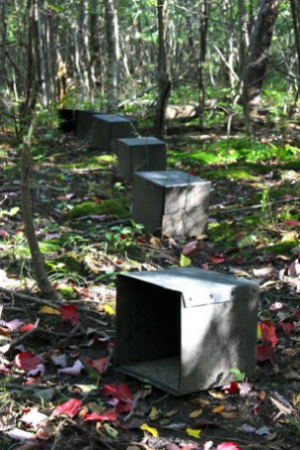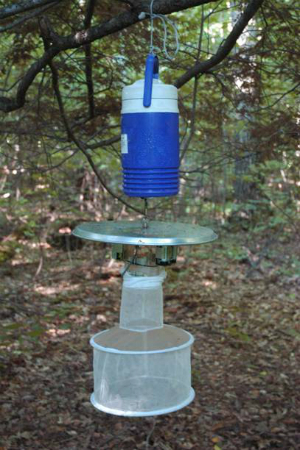Each year the Vector Surveillance Program conducts statewide surveillance of mosquitoes from the beginning of June through mid-October looking for West Nile Virus (WNV) and Eastern Equine Encephalitis (EEE). Mosquitoes are collected from approximately 100 trap sites in 82 towns across Vermont. This program's primary goal is to locate and monitor vector (disease-carrying) mosquitoes in the interest of protecting public health, not to control mosquito populations.
Four types of traps are used: resting box traps, reduced CDC light traps, gravid traps, and BG-Sentinel traps. Resting box traps (RBTs) target the main vector of EEE. Reduced CDC light traps are collocated with RBTs at wetland locations and are used as a sensing tool of the species present. Gravid traps are primarily set at wastewater treatment facilities, targeting the main vector of WNV. Two BG-Sentinel traps are set in southern Vermont. These traps are designed to specifically trap Aedes albopictus mosquitoes, often known as the Zika mosquito, which was detected for the first time in Vermont in 2019. Collections are made weekly and brought to our lab in Randolph Center. Mosquitoes are identified to species and the vector species are pooled into vials of 1 to 50 mosquitoes. The Vermont Department of Health tests the mosquitoes for WNV and EEE. The weekly results of this testing may be found at the "Mosquitoes in Vermont" page on the Vermont Department of Health website. Annual mosquito surveillance reports can be found on the Annual Mosquito Reports page.

Resting box traps target Culiseta melanura, the main vector of EEE. In early June, ten boxes are placed in each wetland location under stands of trees with little understory growth. These boxes are left at these sites for the entire duration of the mosquito surveillance season. After a female mosquito takes a bloodmeal from a host, she settles to the forest floor and finds a dark and quiet place to digest the bloodmeal and create eggs. The mosquitoes are attracted to these boxes for that reason. Each week, a field technician will vacuum out these boxes and the mosquitoes will be pulled into a nylon stocking. While Culiseta melanura is the most common species to find in these traps, other species utilize them as well.


CDC light traps are a great tool to determine the species of mosquitoes that are present in an area. Light traps use dry ice which emits carbon dioxide. Mosquitoes that are looking to feed are attracted to the carbon dioxide and are pulled into a net by a fan that is connected to the dry ice thermos. These traps can yield extremely high numbers of mosquitoes - as many as 30,000 in one night!
Gravid traps target the main vectors of WNV, Culex restuans and Culex pipiens. Gravid (or egg-bearing) females are attracted to the stinky water in these traps (we use a mixture of cow manure and rabbit food pellets) because they like to lay their eggs on the surface of dirty water. When the female goes to lay her eggs, she is pulled into a net by a fan.
BG-Sentinel traps and oviposition cups are used to specifically attract Aedes albopictus mosquitoes. Aedes albopictus (the Asian tiger mosquito) can carry and transmit Zika, dengue, and other arboviruses. It has an estimated geographic range that includes southern Vermont. Aedes albopictus eggs were found at one site in Windham county among 35 trapping sites in Vermont in 2019. Aedes albopictus eggs were found at one site in Rutland county and one site in Windham county among 16 trapping sites in Vermont in 2020.

